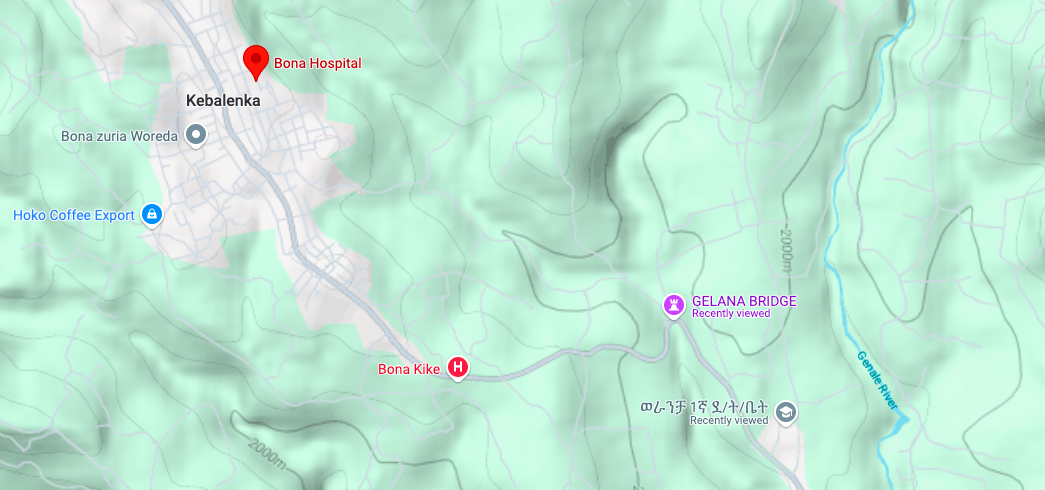Inside Africa: On Ethiopia’s Roads, 71 Passengers Are Killed In Mysterious Accident
The rift valley extends large plateaus of volcanic rock across Ethiopia and East Africa all the way to the Red Sea. Some of Africa’s most dangerous roads stretch across it. Many Ethiopians put their lives at risk every day riding on them.
A few weeks ago, a group was travelling across a southern part of Ethiopia in the Sidama region, a hilly landscape of mostly forests and small fields. It was a minibus carrying a group of people, among them guests returning from a wedding. Or was it a truck and all passengers were guests going to a wedding - they had hired a small truck to take them.
The accounts seem to differ on what actually happened in the Bona district of Sidama region on Sunday 29th December 2024 at around 5:30pm local time. Early witnesses described seeing corpses scattered across the shallow riverbed around the wreck of a vehicle. They tried to help the survivors, but response services took too long to arrive for most. A few survivors were taken to the nearby Bona hospital, but it appears they have since also died.
Some facts about what happened are undisputed: At an altitude of around 2000 metres, a vehicle made its way through a mountainous region of southern Ethiopia. It carried 71 passengers, nearly all of them men - only three were not. As the vehicle swerved downhill around the Gelana Bridge, it rolled off the road and plunged into the roughly 8 metre drop, crashing into the rocks and water below.
Traffic police from the region reported seeing a truck, saying it was overloaded. Yet they apparently did nothing about this. Serak Boko, a villager living nearby, told the Associated Press that he saw people dancing and waving from within the vehicle, which was blasting music moments before the accident.
Further details of what happened remain a mystery. Early reports suggested it was a minibus which carried the passengers to their deaths, but images released by Reuters (who seem to have the first and most referenced account) confirm the vehicle was indeed a small truck. While some sources claimed only a handful of passengers were or had attended a wedding, the Associated Press has claimed all passengers were on their way to a wedding. It explains why most were men: cultural custom requires the men invited to a wedding to escort the bride from her home to the ceremony.
This also explains why it was a truck instead of the previously alleged minibus. It is common in Ethiopia for large groups of people travelling to hire a small truck for transport, rather than a bus. It’s simply a cheaper option, and the laws prohibiting this have weak enforcement. A UN Road Safety Report on Ethiopia claims: “[A] major problem related to rural safety is overloading of vehicles which is common in most rural areas as a result of very low traffic volume. This is one of the most visible signs of noncompliance with safety legislation.”
Yet, this may not have been the sole or indeed main cause of the accident. No witness accounts or reports suggest the truck was hindered by other traffic. According to the World Health Organization (WHO), “every 1% increase in mean speed produces a 4% increase in the fatal crash risk”, and that “the design of roads can have a considerable impact on their safety.” The road leading to the bridge is slightly sloped on both sides, suggesting the truck was coming downhill and possibly at increased speed. This could explain why it missed the bridge.
Another factor may have been Khat. It’s a plant which grows around 2000 metres above sea level in Ethiopia and many other east African countries. People chew the leaves, which administer a euphoric and energetic high after consumption. Because of its heavy usage among some Ethiopian and other East-African peoples, the WHO classifies it as a potential drug of abuse.
Truck drivers have been known to use the plant to keep them awake and focused during long stretches of driving. The same UN Road Safety Report also states: “reckless driving behaviour, including drink-driving and chewing Khat while driving (substance abuse) factors appear to be more crucial in causing safety issues than poor vehicle conditions or overloading.” No reports deny the driver of the Sidama truck was chewing Khat.
To be sure, nothing says he did chew Khat before the accident either. The combination of these elements may not tell the story behind the 71 passengers who met their death on the Gelana Bridge. It is however the story behind many accidents in the rest of Ethiopia. There are many dangerous roads in the country, unsafe driving is common, and deadly accidents occur more than in many other countries of the world. The global average of deaths on the road in high income countries is 8.3 per 100 000 inhabitants. In Ethiopia, it’s close to 27.
Traffic Fatalities in Ethiopia between 2007 and 2018
Since 2007, Ethiopia’s roads have become more and more dangerous. According to the WHO, 3 971 reported fatalities occurred in 2021. They estimate however, that the real number is between 18 000 and as high as 24 000 deaths. Many of these fatalities are pedestrians. However, of the vehicles reporting the highest fatality rates, Buses and Trucks are the leaders at 35.4% and 27.6% respectively.
The World Research Institute (WRI) has been trying to tackle Ethiopia’s road safety issue since 2015 by developing urban infrastructure and improving roads. They’ve supported Ethiopia’s Ministry of Transport and Logistics to implement ‘Car free days’ in many of Ethiopia’s cities, as well as improving public transport, walkways, and bike paths to reduce traffic and the risk to pedestrians. Their goal is to reduce 50% of road deaths by 2030.
They will likely not get far if the roads continue to be dangerous, and people continue to use unsafe means of transportation. However, as this article demonstrates, the sparse media coverage also doesn’t help. Many of the local and international media publications all seem to get their reports on the Gelana Bridge accident from the same source, Reuters (the word-for-word similarity is obvious in many). Further investigation into the events has dwindled, resulting in the dramatic headline without a story.
Sparse reporting on such issues also results in continued recklessness on the roads. Whatever the mysterious reason for the crash was, 71 passengers died in Sidama. More informed reporting on the perils of Ethiopia’s mountainous roads might have saved them. Perhaps, the only true story here is that they simply weren’t aware of the dangers. Many Ethiopians are still vulnerable to such a fate.


